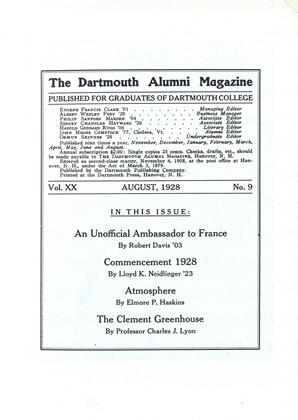Volume IV THE MARCH OF COMMERCE. By Professor Malcolm Keir. (Yale University Press, New Haven, 1927, Pp. 361.) In view of the increasing interest in American social and economic, as well as political, history, it was inevitable that, sooner or later, we should have an adequate pictorial history of American life. Something that would really add to our material conception of the story of the American people. This history the Yale University Press is now giving us in a series of fifteen sumptuous volumes under the general title of The Pageant of America. Of this entertaining and instructive work nine volumes, including those on Commerce and Industry by Professor Keir, have been published already, and the remainder are in preparation.
In volume four of the series, The March ofCommerce, Professor Keir traces the evolution of American commerce from its colonial beginnings to present-day progress in the field of commercial aviation. In the treatment of his subject Professor Keir follows the topical method, with the several topics arranged chronologically in so far as that is possible. Among the topics taken up, to each of which is devoted one of the seventeen chapters of the volume, are such as The Commerce of the Colonies, The Old Merchant Marine, The Spread of the Steamboat, The Railroad Age, The Business of Express, The Letter Post, Voices Across Space, Banking, A Nation on Wheels, Aviation, etc. Each chapter begins with a short introduction, following which the topic under consideration is developed by means of appropriate pictures with brief textural comment accompanying the pictures and carrying forward the story.
The pictures, of course, are the most important and interesting part of the book. Almost nine hundred in number, they have been drawn from every conceivable source and represent no little research on the part of the author. Most are reproductions of authentic pictures, portraits and other survivals, although a few represent imaginative reconstructions based upon such evidence as is now available. There are pictures of old prints and lithographs, of paintings on canvass and chinaware, of maps, charters, and commercial documents of many kinds, together with pictures of boat models, paper and metallic currency, modern photographs, and portraits of many of the men who have made history in the evolution of our commercial life. In other words pictures drawn from every source that would help illuminate the history of American commerce.
In the difficult task of selecting the most worthwhile pictures for his purpose Professor Keir has been most successful. ' Certainly, if the experience of the reviewer is typical, the reader who goes through the volume conscientiously will close it with a more enlightened understanding of what the "March of Commerce" in America actually has been like than could be gained from any unillustrated text alone.
Of course the pictures by themselves could not tell the entire story. Explanations and comments were necessary to tie the pictures together and present the story as a whole. To do this successfully, avoiding too great a lack of continuity "in the treatment of the several topics, was no easy task, and at times the reader senses the author's trials and tribulations in this respect. But on the whole Professor Keir has handled his problem in a manner that leaves little to be desired.
To those who love picture books, and most of us do, especially when they are instructive as well as entertaining, The March of Commerce will prove a fruitful source of information and pleasure.
 View Full Issue
View Full Issue
More From This Issue
-
 Article
ArticleTHE UNOFFICIAL AMBASSADOR TO FRANCE
August 1928 By Robert Davis '03 -
 Article
ArticleEditorial Comment
August 1928 -
 Article
ArticleMEETING OF ALUMNI COUNCIL
August 1928 -
 Books
BooksGREEK THOUGHT IN THE NEW TESTAMENT.
August 1928 By Charles D. Adams -
 Sports
SportsSUMMARY OF ATHLETIC SCORES
August 1928 -
 Class Notes
Class NotesClass of 1918
August 1928
W. R. Waterman
-
 Books
BooksTHOMAS JEFFERSON. THE APOSTLE OF AMERICANISM.
FEBRUARY 1930 By W. R. Waterman -
 Books
BooksTHE GOLDEN STAR OF HALICH; A TALE OF THE RED LAND IN
NOVEMBER 1931 By W. R. Waterman -
 Books
BooksTHE AMERICAN AGRICULTURAL PRESS
April 1941 By W. R. Waterman -
 Books
BooksTHE JEFFERSONIANS, A STUDY IN ADMINISTRATIVE HISTORY
November 1951 By W. R. Waterman -
 Books
BooksA SHORT HISTORY OF AMERICAN LIFE.
October 1952 By W. R. Waterman -
 Books
BooksTHE ROAD TO RENO.
June 1962 By W. R. WATERMAN
Books
-
 Books
BooksAlumni Articles
JANUARY 1967 -
 Books
BooksEUROPE AND THE AMERICAN CIVIL WAR.
June 1931 By A. Howard Meneely -
 Books
BooksFACULTY PUBLICATIONS
January 1916 By E. D. DICKINSON -
 Books
BooksTen-Second Cities
April 1976 By FRANKLIN SMALLWOOD '51 -
 Books
BooksA CENTURY OF GENEALOGICAL PROGRESS
June 1946 By Gertrude B. Wright -
 Books
BooksTHE LOGIC OF LANGUAGE
November 1939 By Stearns Morse


